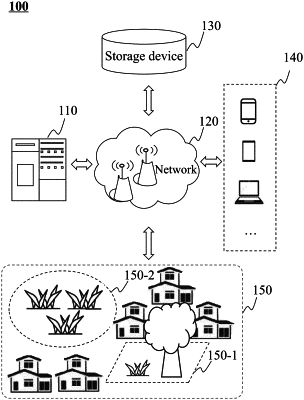| CPC G05B 19/042 (2013.01) [G05B 2219/2625 (2013.01)] | 4 Claims |

|
1. A distribution method for greenspace irrigation water of a smart city based on an Internet of Things, wherein the distribution method is performed by an urban management platform, comprising:
obtaining historical monitoring information of a plurality of greenspaces in a target area within a historical time period from an urban monitoring object platform through a sensor network platform; determining historical growth information of the plurality of greenspaces within the historical time period based on the historical monitoring information of the plurality of greenspaces;
for each greenspace, obtaining historical irrigation parameters of a greenspace within the historical time period through an irrigation object platform and obtaining historical environment information of the greenspace within the historical time period through the urban monitoring object platform; determining first growth information of the greenspace within a first future time period through a growth condition prediction model based on the historical growth information, the historical irrigation parameters, and the historical environment information; wherein the growth condition prediction model is obtained by training an initial growth prediction model based on a plurality of sets of training samples with labels, and the training samples include sample growth information, sample irrigation parameters, and sample environment information of sample greenspaces within a first sample time period, the labels are growth information of the sample greenspaces within a second sample time period, and the first sample time period is earlier than the second sample time period;
obtaining a preset total amount of irrigation in the target area within the first future time period; and
determining target irrigation parameters combined corresponding to the each greenspace with a preset algorithm based on the preset total amount of irrigation and the first growth information of the each greenspace, wherein the preset algorithm includes at least one round of iterative updation, and one round in the at least one round of iterative updation includes:
updating a multi-dimensional increment to be processed to obtain a multi-dimensional increment after a current round of iterative updation; determining the multi-dimensional increment after the current round of iterative updation as the multi-dimensional increment to be processed in a next round, wherein the multi-dimensional increment includes a plurality of increment elements corresponding to the plurality of greenspaces and each increment element of the plurality of increment elements represents an adjustment range of irrigation water amount for the corresponding greenspace; and updating an increment element to be updated in the multi-dimensional increment to be processed including:
updating the increment element to be updated based on a current loss in a previous round, wherein the current loss in the previous round is determined based on a difference between candidate irrigation water amount elements obtained in the previous round and a historical optimal candidate irrigation parameter; and
for candidate irrigation parameters to be processed in the greenspace of the plurality of greenspaces of the candidate irrigation schemes to be processed, updating the candidate irrigation parameters to be processed based on an updated increment element corresponding to the greenspace in the multi-dimensional increment after the current round of iterative updation to obtain the candidate irrigation schemes after the current round of iterative updation, wherein the candidate irrigation schemes after the current round of iterative updation are determined as the candidate irrigation schemes to be processed in the next round;
if a total amount of irrigation of the plurality of greenspaces in the candidate irrigation schemes after the current round of iterative updation is greater than the preset total amount of irrigation, reducing the irrigation water amount of the each greenspace in the candidate irrigation schemes after the current round of iterative updation according to a ratio, wherein the ratio is determined based on a ratio of the total amount of irrigation of the plurality of greenspaces to the preset total amount of irrigation;
generating an irrigation control instruction for the each greenspace based on the target irrigation parameters;
and sending the irrigation control instruction to the irrigation object platform through the sensor network platform, wherein the irrigation object platform is configured to irrigate the each greenspace in response to the irrigation control instruction.
|